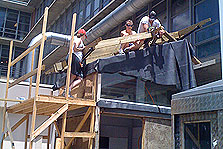
 Enlarge image
Enlarge imageUniversity of Cincinnati students construct the basic structure of an experimental research module that will accommodate salvaged parts of [re]form house.
(Courtesy of Anton Harfmann)
Who: University of Cincinnati
What: [re]form house
Where:
University of Cincinnati campus
5470 Aronoff Center
Cincinnati, OH 45221
Map This House
Public tours: Not available
Solar Decathlon 2007
University of Cincinnati: Living Up to Its Name
Built for the U.S. Department of Energy Solar Decathlon 2007, the University of Cincinnati's [re]form house was dismantled in spring 2009. Approximately 90% of the building materials were recycled to recover some of the project's cost. Materials such as pumps, evacuated tubes, PV panels, electrical equipment, lumber, and connectors were then reused on a research module that consists of a roughly 8-ft x 8-ft steel shell.
"The idea behind the research module is to let students experiment," says Anton Harfmann, faculty leader. He explains that the piecemeal components allow for easier access to specific features.
In 2013, a new student project began to take shape to use the remaining PV panels and evacuated tubes from the house in an experimental, high-temperature thermal energy storage project and a PV car recharging station. Organized jointly by the engineering and architecture programs and funded by the campus utility plant, the project will provide carbon-free charging for faculty members’ electric vehicles.
Immediately after the Solar Decathlon, the house was reconstructed in front of McMicken Hall on campus. Several students experimented on the house while looking at ways to produce electricity from solar-heated water. One course evaluated all 20 of the houses that competed in Solar Decathlon 2007. The findings were used as the basis for a book by Professor Michael Zaretsky called "Precedents in Zero-Energy Design." These ideas were further explored as Zaretsky led an effort to build a health center in Roche, Tanzania, powered by renewable energy.
[re]form was originally designed to accomplish three objectives. The student-led Solar Decathlon team hoped that its house would transform the way people think about energy-efficient living, inform visitors about how solar energy can be seamlessly integrated into everyday life, and perform both technologically and as a work of art.
Students have experimented with the exterior envelope, plumbing, green wall, and cooling system on the research module. "It really is more of a teaching tool now," says Harfmann. One that can be reformed over and over again.
